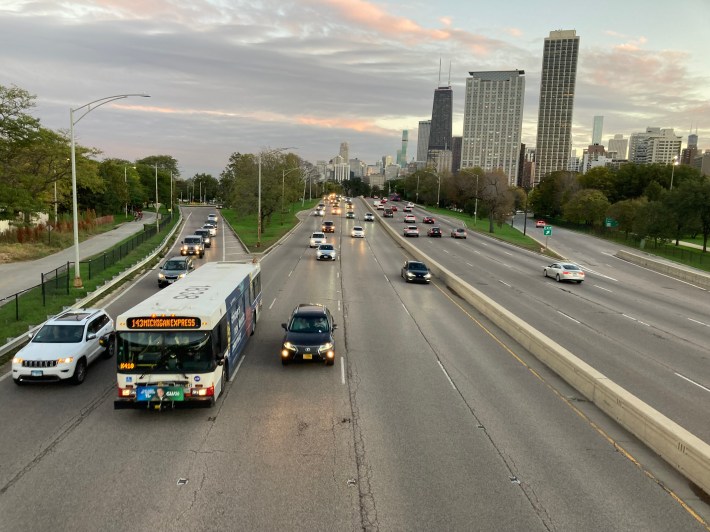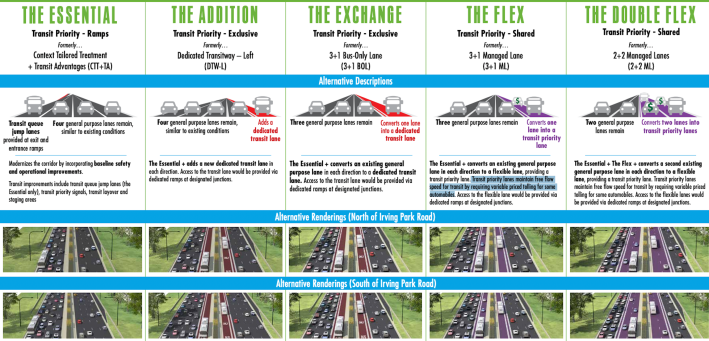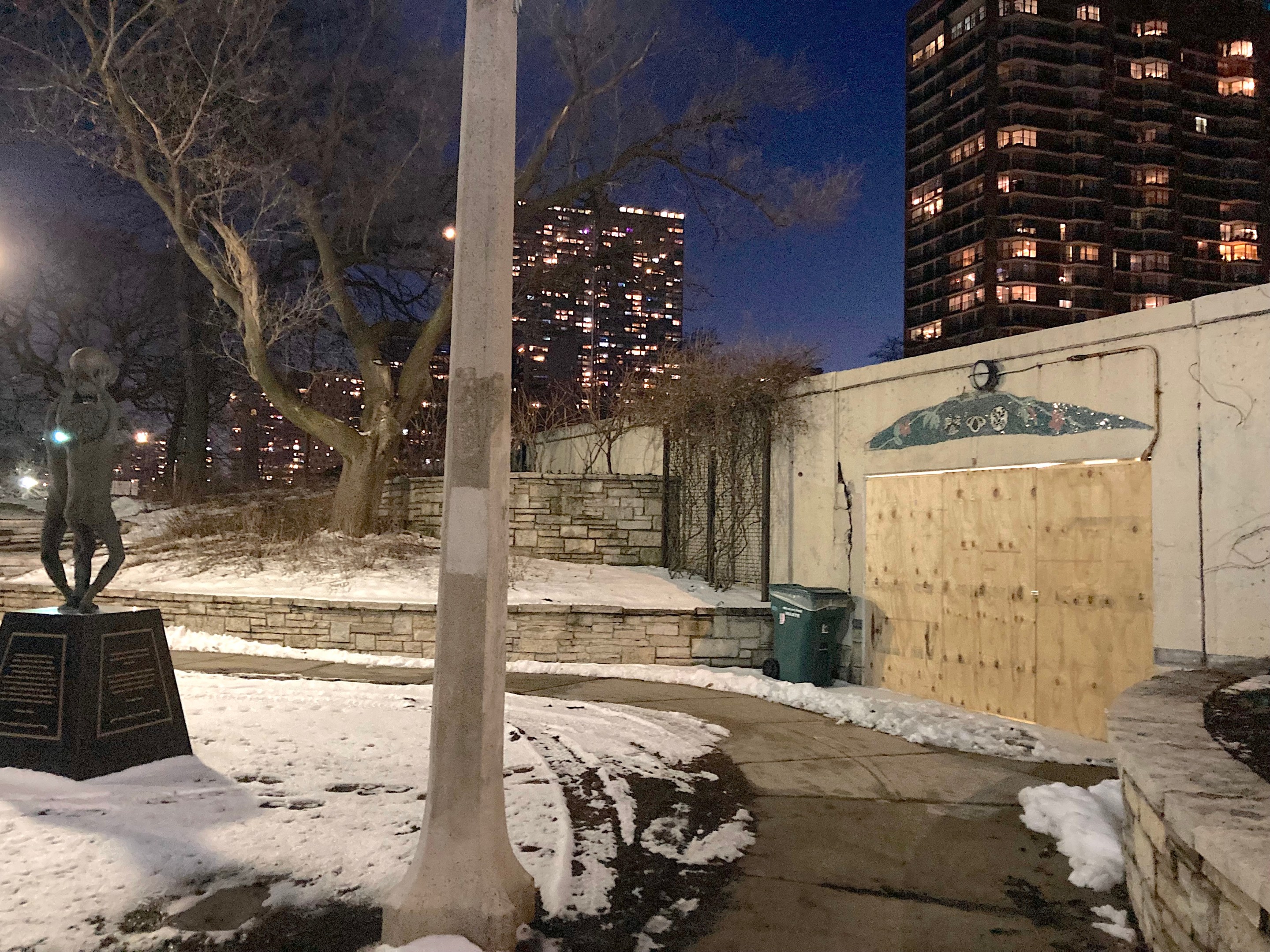At the end of February, the Chicago Department of Transportation abruptly boarded up the Buena Avenue underpass below DuSable Lake Shore Drive in Uptown after discovering dangerous structural damage. The passageway is just one of many tunnels and bridges that provide a grade-separated connection between neighborhoods and the lakefront for people on foot and bikes.
Around that same time, Hyde Park transportation advocate Steven Lucy posted an image of another DLSD underpass at 55th Street in Hyde Park that was severely flooded. In each case, the impassible viaduct meant pedestrians and cyclists were forced to detour up to half a mile out of their way to safely cross the six- or eight-lane highway. Both situations are apt metaphors for the city’s inadequate approach to mobility, lakefront management, and environmentally sustainable practices.
Just once I want the car infrastructure to flood and the adjacent pedestrian infrastructure to be dry. pic.twitter.com/9H0WNWGRfM
— Steven Lucy (@slucy) February 22, 2022
The closed and obstructed underpasses along DLSD are symptoms of a larger problem, which is the existence of the massive lakefront roadway itself, which is exacerbated by its profoundly car-centric and anti-urban design. While the highway remains extremely popular in Chicago’s collective imagination, it is time we seriously reassess the drive’s place in the city’s transportation system and honestly discuss its many negative impacts. Not least among these is the way DLSD cuts residents off from the city’s most beloved natural feature and public space: the Lake Michigan shoreline.
The Lakefront Trail is one of the few spaces in Chicago that is dedicated to and (at least in theory) safe for people on foot and bike. It is also one of only a handful of off-street paths in Chicago that are useful for bike commuting. In many locations it can only be accessed by underpasses that are not-infrequently impassible due to flooding, and are often in terrible shape, in some cases nearly as bad as Buena. Whether that's due to bad design and weather-proofing, or simply neglect, it reflects the city’s lack of regard for the safety and convenience of pedestrians and cyclists (existing and potential), and its preoccupation with making driving as easy as possible. It begs the question: If city officials do such a bad job of maintaining access to Chicago's favorite multi-modal corridor, then what are their real mobility priorities?
Unfortunately, while City Hall often gives lip service to the importance of fighting climate change and making Chicago a world-class city for walking and biking, it appears that decision-makers don't actually care that much about creating a sustainable or equitable transportation network. That's obviously the case in Springfield as well, judging by Governor J.B. Pritzker's vocal support for using much funding from Illinois' projected $17 billion from the new federal infrastructure bill for widening expressways and Interstates.
On a daily basis Chicagoland residents experience the indignities and frustrations of a transportation system where resources are concentrated on the futile task of trying to make it convenient to travel around a dense city and region in large metal boxes that usually only have a single occupant. Instead we should focus on the efficient, sustainable, and equitable movement of people.

DuSable Lake Shore Drive continues to be one of the worst examples of this reality. Not only does it dismember the city from the lake, it induces demand for driving where there should be little need for it, and this produces all the expected negative side effects. For nearby residents it is a disruptive highway in the local park. It is source of noise pollution, air pollution, and drivers careening into the park from off-ramps. It generates traffic jams, often in neighborhoods that have good transit and bike access, where it's relatively easy to avoid driving.
Worse, it seems like every level of government responsible for the design, management, and maintenance of DLSD is in denial about the fact that we must design for a future with less driving, and more walking, biking, transit use, and green space. Disappointingly, the planning process for North DuSable Lake Shore Drive reconstruction project isn't considering an alternative that reduces the footprint of the highway, and it's possible that the final design won't even include dedicated bus lanes. Absurdly, there's still a possible scenario on the table that would involve adding two more lanes to the drive.

The New York Times recently highlighted the fact that road expansion induces more drive, creating more climate-changing emissions, specifically calling out the Eisenhower Expressway expansion proposal. Considering that the phenomenon of induced demand is well-established (albeit not well-known) knowledge, the city and state need to go back to the drawing board and come up with a new design that would convert a significant number of motor vehicle trips to walking, biking, and transit trips. That is, a smaller road footprint with bus rapid transit or light rail, with more space for pedestrians and cyclists, such as the one that the advocacy group Better Streets Chicago has proposed..

And if the city and state are incapable of mustering the political courage to change course and choose a better design for the North DuSable Lake Shore Drive reconstruction, then it is up to the public to force them to do so.
We can no longer accept urban transportation planning that largely ignores the needs of existing and potential pedestrians, bike riders, and transit users, instead pandering to drivers who incorrectly believe that if we build more travel lanes, they won't have to stew in traffic jams. This is not a dress rehearsal; We need to take bold action now to save our communities and planet from being destroyed by global warming.
Closed underpasses aren't just inconvenient. They also highlight the inconvenient truth that our addiction to cars is contributing to the existential threat of climate change. Rethinking and shrinking the drive is one step we can take to help reverse that.





